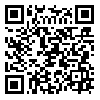Volume 80, Issue 10 (January 2023)
Tehran Univ Med J 2023, 80(10): 789-797 |
Back to browse issues page
Download citation:
BibTeX | RIS | EndNote | Medlars | ProCite | Reference Manager | RefWorks
Send citation to:



BibTeX | RIS | EndNote | Medlars | ProCite | Reference Manager | RefWorks
Send citation to:
Moghadas F, Amini Z, Kafieh R. Deep learning approach for motor imagery EEG signal classification. Tehran Univ Med J 2023; 80 (10) :789-797
URL: http://tumj.tums.ac.ir/article-1-12151-en.html
URL: http://tumj.tums.ac.ir/article-1-12151-en.html
1- Department of Biomedical Engineering, School of Advanced Technologies in Medicine, Isfahan University of Medical Sciences, Isfahan, Iran.
Abstract: (1249 Views)
Background: Brain-computer interface systems provide the possibility of communicating with the outside world without using physiological mediators for people with physical disabilities through brain signals. A popular type of BCIs is the motor imagery-based systems and one of the most important parts in the design of these systems is the classification of brain signals into different motor imagery classes in order to transform them into control commands. In this paper, a new method of brain signal classifying based on deep learning methods is presented.
Methods: This cross-sectional study was conducted at Isfahan University of Medical Sciences, School of Advanced Technologies in Medicine, from February 2020 to June 2022. In the pre-processing block, segmentation of brain signals, selection of suitable channels and filtering by Butterworth filter have been done; then data has transformed to the time-frequency domain by three different kinds of mother wavelets including Cmor, Mexicanhat, and Cgaus. In the classification step, two types of convolutional neural networks (one-dimensional and two-dimensional) were applied whereas each one of them was utilized in two different architectures. Finally, the performance of the networks has been investigated by each one of these three types of input data.
Methods: This cross-sectional study was conducted at Isfahan University of Medical Sciences, School of Advanced Technologies in Medicine, from February 2020 to June 2022. In the pre-processing block, segmentation of brain signals, selection of suitable channels and filtering by Butterworth filter have been done; then data has transformed to the time-frequency domain by three different kinds of mother wavelets including Cmor, Mexicanhat, and Cgaus. In the classification step, two types of convolutional neural networks (one-dimensional and two-dimensional) were applied whereas each one of them was utilized in two different architectures. Finally, the performance of the networks has been investigated by each one of these three types of input data.
|
Results: Three channels were selected as the best ones for nine subjects. To separate 8-30 Hz, a 5th degree Butterworth filter was used. After finding the optimal parameters in the proposed networks, wavelet transform with Cgauss mother wavelet has the highest percentage in the both proposed architectures. Two-dimensional convolutional neural network has higher convergence speed, higher accuracy and more complexity of calculations. In terms of accuracy, precision, sensitivity and F1-score, two-dimensional convolutional neural network has performed better than one-dimensional convolutional neural network. The accuracy of 92.53%, which is obtained from the second architecture, as the best result, is reported.
Conclusion: The results obtained from the proposed network indicate that suitable, and well-designed deep learning networks can be utilized as an accurate tool for data classification in application of motion perception. |
Keywords: brain-computer interface (BCI), classification, deep learning, electroencephalography (EEG).
Type of Study: Original Article |
| Rights and permissions | |
 |
This work is licensed under a Creative Commons Attribution-NonCommercial 4.0 International License. |





